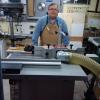I would say i'm a beginner of "fine woodworking", but i've been building stuff for 20 years. Gazeebo Eagle Scout project, deer stands, garage storage, fences, car ports, remove load bearing wall.....
I'm in Wisconsin USA and learned on the imperial system, but i'm wondering if I should start measuring things and using tools in Metric.
Any of you Americans make the switch and wish you did sooner?
Any not so obvious reasons why I should not and just stick to Imperial?
Is Metric more accurate or precise?






 Reply With Quote
Reply With Quote





